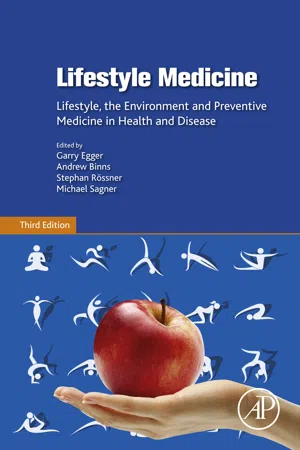
Lifestyle Medicine
Lifestyle, the Environment and Preventive Medicine in Health and Disease
- 484 pages
- English
- ePUB (mobile friendly)
- Available on iOS & Android
Lifestyle Medicine
Lifestyle, the Environment and Preventive Medicine in Health and Disease
About this book
Lifestyle Medicine: Lifestyle, the Environment and Preventive Medicine in Health and Disease, Third Edition, is an adjunct approach to health practice that seeks to deal with the more complex modern determinants of chronic diseases—primarily lifestyle and the environments driving such lifestyles—in contrast to the microbial 'causes' of infectious disease.Our lifestyle choices have a profound effect on our health. As we live longer, one thing is clear: many of us will spend time living with injury and chronic illness due to our own choices. Changes in health patterns typically follow shifts in living conditions. Disease patterns have changed worldwide, from infectious to chronic diseases such as obesity, diabetes, and heart disease. This change has been so emphatic—nearly 70% of all presentations to a doctor in modern western societies are now chronic disease related—that medical services are being forced to change to accommodate this.New chapters in this third edition explain the link between energy intake and expenditure; consider how modern technology are determinants of chronic disease; show how environmental influences, such as endocrine disruptors, influence our health; and summarize recent research on early childhood experiences and chronic disease.- Explores the relationship between lifestyle and environmental drivers and the major modern chronic diseases- Outlines the knowledge and skills bases required by health professionals to deal with lifestyle and environmental determinants of chronic disease, as well as the tools and procedures available for doing this- Develops pedagogy for Lifestyle Medicine that will enable it to become a practical adjunct to conventional health and medical practice- Features new chapters explaining the link between energy intake and expenditure, and more
Frequently asked questions
- Essential is ideal for learners and professionals who enjoy exploring a wide range of subjects. Access the Essential Library with 800,000+ trusted titles and best-sellers across business, personal growth, and the humanities. Includes unlimited reading time and Standard Read Aloud voice.
- Complete: Perfect for advanced learners and researchers needing full, unrestricted access. Unlock 1.4M+ books across hundreds of subjects, including academic and specialized titles. The Complete Plan also includes advanced features like Premium Read Aloud and Research Assistant.
Please note we cannot support devices running on iOS 13 and Android 7 or earlier. Learn more about using the app.
Information
Nutrition for the Nondietitian
Abstract
Keywords
Introduction: The Confusion of Nutrition
The Science of Nutrition
The Concept of (Energy) Volume
Table of contents
- Cover image
- Title page
- Table of Contents
- Copyright
- About the Editors
- About the Authors
- Preface
- Section I. Background and Basis for the role of lifestyle factors In chronic disease Prevention and Treatment
- Section II. Lifestyle and Environmental Determinants of Chronic disease
- Section III. Other issues for Lifestyle medicine
- Section IV. The Future of Health
- Index